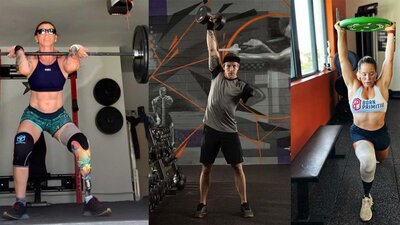
4 Adaptive Athletes Making CrossFit History
Meet four of the men and women who have overcome incredible challenges to thrive in their daily lives and compete on the world stage in the inaugural CrossFit Games Adaptive Division.
CrossFit Games Main | CrossFit Games Preview | Logan Aldridge Profile | Lauren Sheehan Profile
Adaptation is a core value of CrossFit, and this year marks the first time ever that adaptive athletes will have the opportunity to compete in their own unique divisions alongside their peers.
For these athletes, the loss of a limb or impaired neuromuscular control is no reason to stop moving. They use love of training and their passion for CrossFit as motivation and inspiration, spreading a message of strength and inclusivity to everyone who sees them hard at work.
Meet four of the many adaptive athletes set to compete in the three adaptive categories of the 2021 CrossFit Games—upper extremity, lower extremity, and neuromuscular—and learn how they were able to take their personal setback and turn it into success.
SARAH RUDDER | WOMEN'S LOWER EXTREMITY DIVISION
As a Marine responding to the attacks on the Pentagon on 9/11, Sarah Rudder suffered a leg injury that ultimately resulted in amputation. She was in a wheelchair for year following her injury and used exercise, specifically CrossFit, to drop 60-plus pounds—and then take her strength and fitness to new heights.
She continues to participate in the sport for mental and physical exercise, using her voice and her story to encourage others who have gone through similar experiences to hope and get active. Although she has left the Marines, Rudder promotes the Catch a Lift Fund, an organization dedicated to the mental and physical healing of veterans. She lives in Oceanside with her husband and son.
NATALIE BIEULE | WOMEN'S LOWER EXTREMITY DIVISION
Natalie Bieule was involved in a serious car accident at the age of 18, leading to the amputation of her right leg below the knee. Bieule never let herself believe that her active life was over, though. Her optimism carried her to the 2016 Paralympic Games in Rio, where she competed in the discus.
She began participating in CrossFit in 2013 as a way to show her children that she should not be seen any differently than any other mom out there. And now, 20 years after her accident, she will compete in the CrossFit Games.
"CrossFit has brought so much to my life," says Bieule. "Not just the challenges and the self-growth as an athlete, but most importantly, the amazing people who have stood behind me all these years pushing me toward this moment—a moment that I myself thought would never happen."
SYLVANIA HARROD | MEN'S NEUROMUSCULAR DIVISION
Sylvania Harrod was wounded while in the Army, causing him to suffer from more than 20 different disabilities. He deals with daily intense nausea, migraines, overwhelming fatigue, and barely has any feeling in his left hand or left leg.
He says of CrossFit, "It has taught me how to move forward and excel in life regardless of how my body feels that day. CrossFit has given me something back in my life that I didn't have the first year of my disease attacking me: It has given me a sense of purpose."
LOGAN ALDRIDGE | MEN'S UPPER EXTREMITY DIVISION
Logan Aldridge lost his left arm just below the shoulder following a boating accident at the age of 13. Already an avid extreme sports athlete, Aldridge barely let the injury slow him down, using his experience to launch a career in motivational speaking while still in his teens. Aldridge discovered CrossFit early in his adulthood, using it to, in his words, "make my one arm as strong as two."
Over the past several years, Aldridge has worked with other adaptive athletes to create the Adaptive Training Academy, an educational organization dedicated to creating greater awareness, understanding, and inclusivity of adaptive athletes. It was this organization that helped bring the Adaptive Athlete Division to the CrossFit Games, giving Aldridge the opportunity to both promote his organization and compete alongside other adaptive athletes.
